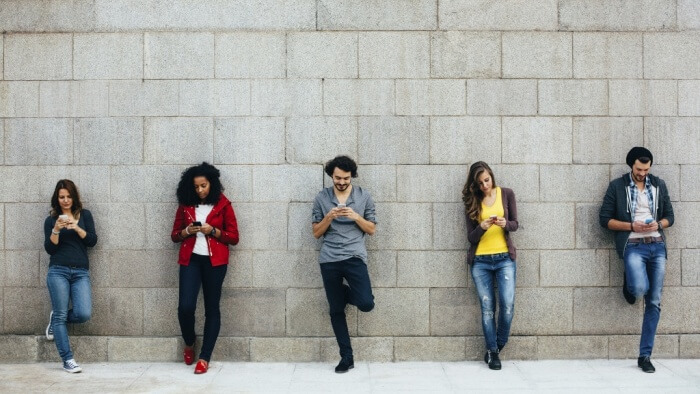How The Most Popular Word Became An Image
What does the rise of visual messaging say about future communications in business?

A picture is worth a thousand words.’ A phrase which has never been more relevant, or true in the digital world we now find ourselves living in.
Think about the everyday communications you make. How many of them include some form of image? Whether it’s an emoji in a text, smiley face in an email, meme shared on social media or creative content shared online – our interactions are more visual than they have ever been before.
The language we communicate in is changing from words to images. No longer can a word necessarily describe how we feel. A visual alongside a message can help to reinforce what we’re trying to communicate. Or, when presented on its own, be even more powerful than words themselves.
Even the English Dictionary is aware of the impact imagery is having on words. In 2015 they declared an emoji – the face which is crying with laughter - to be the word of the year. And while Google removed the ability to search by emoji; Instagram, Bing and Yelp all allow you to search by those infamous little images.
In a world where our communications are becoming increasingly visual, brands are getting on board too. Complex feelings can now be communicated visually, rather than through language. Allowing us to share happiness, joy, sadness, frustration and anger in a new kind of digital intimacy.
But, how did we become so reliant on imagery? Until the late 90s, when the first emoji was introduced, we were all perfectly happy communication through text. So, what’s led the communicative landscape to change?
Rise of Visual Language
Look around any group of friends, office or social gathering and you’ll see everyone glued to their phones. Even when we’re in social company we can’t be drawn away from the tech that now rules our lives.
One of the largest changes in recent years is our dependency on having everything instant. We’re not used to waiting longer than a day for a delivery or longer than 5 minutes for a text to be received. Answers are provided instantly in 2016.
The one thing contributing to the biggest change in our communications? Messaging platforms. Growth of apps such as WhatsApp and Facebook Messenger has now overtaken social networks, meaning we are now more connected than ever before, thus shaking up the language we communicate in.
Marketers Are Adapting
While, as consumers we are all used to conversing visually, marketers are having to adapt their communications to follow suit. Brands on social media now converse far more causally and intimately with their audiences than they ever did before, with visuals being used to reinforce messaging and add to the share-ability factor.
It all comes down to brand affinity. A brand which you find yourself gravitating toward on a personal level is much more likely to resonate with you and therefore entice you to interact. It’s the use of casual language that allows brands to seamlessly fit into our everyday communications, and before we know it we’re replying to them without thinking twice.
Brands are showing consumers they fit in. They’re part of the ‘in crowd’ and can speak the same language and act the same too. The relationship is no longer one of teacher and student, between brand and customer. The relationship is on an equal level and creates higher engagement levels due to better communication lines.
Importance of Using the Right Imagery
There is a temptation amongst brands and businesses to use imagery for the sake of it. If it’s not relevant to your campaign or audience, don’t post it. There’s nothing worse than coming across a campaign and seeing a piece of content sticking out like a sore thumb because it isn’t on brand. Trends are great to follow, but only go with them if they work for you.
Investing in creating your own imagery should be a priority. Stock images may be seen as the easy option but they can be costly, and mean others can also use the same images elsewhere. Don’t make business creatives an afterthought, imagery is even more powerful than words, so invest from the start.
Images spark a debate and create powerful personal connections which a textual interaction cannot.
What’s Next?
While imagery is nothing new in both the physical or digital domains, it is something which is largely associated with offline campaigns. Bridging the gap between both worlds is seen a priority for brands – marrying the offline and online worlds together. Emoji’s jumping from the digital realm to the physical world is an emerging trend; with Pepsi trialling Pepsimoji cans and bottles in Canada.
Twitter recently changes its character limit on the platform so that it doesn’t include images in the 140-character allowance – proving they know the benefits an image brings to language. In February Twitter introduced GIF (a file which shows animated and static images) search functionality – enabling users to express themselves in yet another way.
Consumers as the image? The filters and faces on Snapchat transform users into different characters allowing them to animate themselves. Allowing their physical being to interact digitally, and become the communication tool, Snapchat are completely blending the boundaries between what’s real and what isn’t.
Where language goes next? Who knows. But it’s clear that the revolution has begun.
Richard LeCount is the Sales and Marketing Manager at USB4Photographers providing branded USBs and USB gift boxes for photographic clients.
Thanks for signing up to Minutehack alerts.
Brilliant editorials heading your way soon.
Okay, Thanks!



